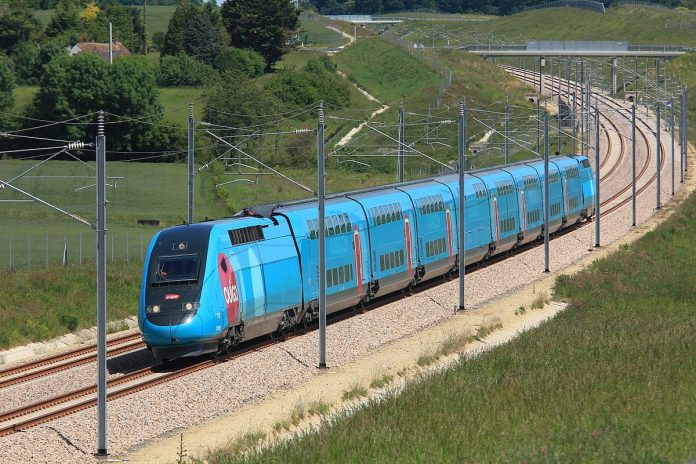A feasibility report on ultra high-speed surface transportation in the Cascadia region was released two weeks ago. The $300,000 study was commissioned by the Washington State Legislature earlier this year. A delegation from the Governor’s Office, Washington State Department of Transportation (WSDOT), and CH2M (the consultant) presented key findings and rationale for developing an ultra high-speed transportation network stretching from Vancouver, British Columbia to Portland, Oregon.
Often referred to as the the “Cascadia Corridor,” the two states and province have an active passenger rail system operated by Amtrak at conventional speeds on more than 400 miles of track. Trains are limited by at-grade crossings, tight curves, and lack of catenary power systems in addition to modern high-speed rail trainsets. The report, however, suggests that the corridor is well positioned to facilitate a successful high-speed rail network.
“This is about investing in ourselves and in the broader Cascadia region and in these tough times we need more openness, more connectivity, more trade, not less,” said Charles Knutson, Executive Policy Advisor to Governor Jay Inslee. “This could be a really powerful symbol of not just a working relationship, but friendships and family relationships that we have throughout the Cascadia region.”
Nuts and Bolts of the Study
Three technologies were evaluated as part of the feasibility study. Two of these technologies are already operational globally and in public use, such as traditional TGV- and Shinkansen-style high-speed rail as well as small meglev systems in Shanghai and Nagoya. A third alternative technology, a literal and figurative pipe dream, known as “hyperloop,” was also tacitly studied. That technology is promoted by anti-transit electric automobile booster Elon Musk.
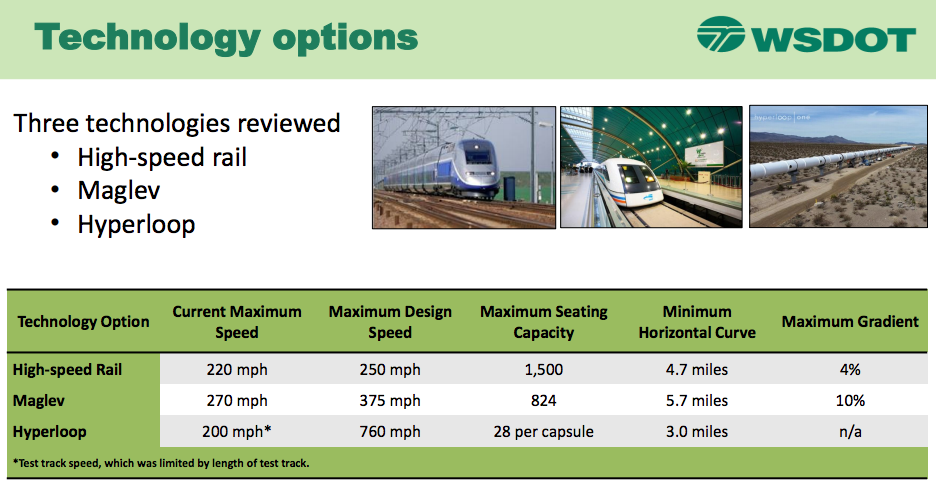
During the presentation, Scott Richman from CH2M described the different features of three evaluated technologies:
- High-speed rail as using conventional rail strategically laid for high-speed and aerodynamicaly designed trains powered by electrical transmission systems;
- Maglev as a floating system using a magnetic and guidance system powered by electromagnetic fields to levitate trains; and
- Hyperloop as a vacuum tube-style version of maglev.
In terms of anlazying feasibility of corridors, passengers, funding and costs, and technologies, CH2M used a traditional model developed by the Federal Railroad Administration (referred to as “CONNECT“) and a variety of time periods to develop estimates. 2015 forms the baseline for analysis with 2035 as the initial forecast year and a 20-year time horizon from that to 2055. Other screening criteria were also used in developing the study results, such as:
- A minimum average operational speed of 250mph;
- Fully grade-separated alignments;
- Population near possible station locations;
- Overall connectivity with existing multimodal options; and
- Standard turning radii of at least 45,000 feet.
Study Finds High-Speed Rail Feasible
The feasibility study evaluated five corridors between Vancouver, British Columbia and Portland, Oregon. This was whittled down to three primary corridor options (noted in green in the table below). The study suggests that 12 daily roundtrips would be the ideal level of service at launch. Higher numbers of roundtrips beyond 12 would begin to see diminishing returns, at least at first.
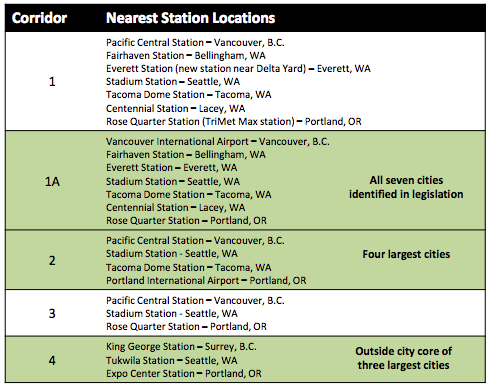
A notable difference between Corridor 1 and Corridor 1A is the terminus in Vancouver, British Columbia. Corridor 1 would terminate trains at the existing central railway terminal east of Downtown Vancouver. Corridor 1A, however, would terminate trains near Vancouver International Airport. Separately, CH2M evaluated options to connect to Spokane via Stampede Pass using mostly existing traditional rail lines but at modestly high speeds (around 90mph) as well as linking with California High Speed Rail in Sacramento.
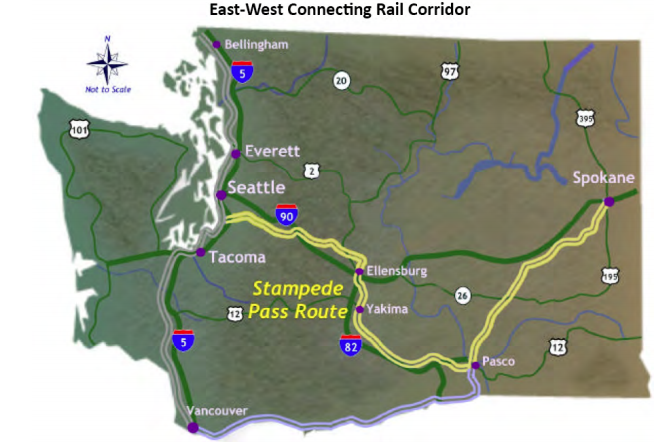
The best corridor for ridership according to the feasibility study is Corridor 1A, which could garner between 2.0 and 2.1 million passengers in 2035, depending upon whether conventional high-speed rail or maglev technology is used (maglev performed slightly better due to speed). Corridor 4 performed the worst for ridership in the study, but would also be the cheapest option from a construction standpoint.
CH2M assumes that somewhere between 13% and 17% of travelers along the high-speed rail corridor would opt for taking a bullet train in 2035. Looking at a longer time horizon out to 2055, bullet trains could generate ridership somewhere between 2.8 to 3.2 million passengers annually.
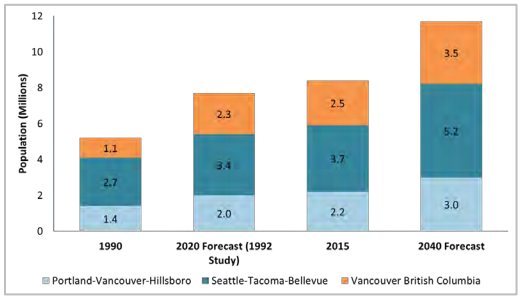
Capital costs to deliver high-speed rail would not come cheap. Richman bluntly stated to the transportation committee that costs were “astronomical.” But it takes a fairly narrow lens to arrive at that conclusion (e.g., neglecting to account for costs in providing equivalent highway capacity increases and costs to the public and business by congestion delays).
The feasibility study suggests that capital costs could top $42 billion if flashy technology and extensive tunneling is used. On the lower end, capital costs could come in at around $24 billion. CH2M also indicated that capital costs could fall a further 25% or more once a more detailed review of options is completed. The cost estimates, however, come with a variety of important caveats:
- Coventional high-speed rail has a wide spread of potential capital costs since it presents a more flexible means of constructing alignments. Tunnel heavy options will obviously result in much higher cost estimates, but general property acquisition and bridging can also balloon prices.
- Maglev has higher capital outlays since the overall route would need to be fairly straight. That means an alignment may require incredible amounts of tunnel and right-of-way acquisitions to maintain very high speeds. Obvious challenges include urban areas where land comes at a premium, but even mountains and tight river valleys in Northwest and Southwest Washington present clear impediments.
- Hyperloop costs are entirely unknown since the technology is purported to be under development. What is known is that the technology would move an order of magnitude fewer people per direction per hour, has more technical constraints than either of the two primary methods used today, and would easily exceed any of the costs of real-world operational options rendering it moot for further analysis–and that’s all assuming it could ever moves faster than the alternatives which it currently does not.
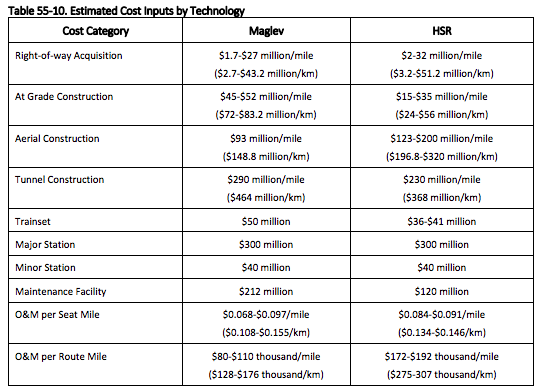
While ongoing operational funding for ultra high-speed ground transportation would largely come from fares, public subsidies may be required, particularly in early years. Eventually, the corridor could become financially profitable. Upfront costs could be paid for through a mix of state and federal grants, loans, and bonds. Third parties may be also be interested in using a public-private partnership model to finance construction and operate the corridor. Other funding sources could include private financing from foreign infrastructure banks or Private Activity Bonds, which were used by Brightline in Florida. The Canadian and British Columbian governments may also utilize similar tools.
An interesting finding in the feasibility study was that maglev would be projected to become profitable sooner than conventional high-speed rail. CH2M suggests that a maglev corridor could fully fund operational costs by 2035 while conventional high-speed rail would achieve full operational cost recovery by 2055. In a way, that makes some sense since costs for overall maintenance and operations would be lower and ridership would be slightly higher with maglev.
However, it’s not clear how costs for conventional high-speed rail might be reduced if tracks were shared with commuter and subregional intercity routes. The analysis does not get that deep, only going as far to consider multimodal connections at stations–like a new east-west rail line to Spokane terminating at King Street Station in Seattle. The study explicitly states the the CONNECT model’s limitations make it difficult to assess the impact of trips shorter than 50 miles. A more detailed study might be able to pick that and give greater credence and value to conventional high-speed rail.
Next Steps
The report is just the first step in building the business case for more detailed planning and formal high-speed rail program. Next month, the Governor’s Office will release an economic analysis of building out a modern high-speed rail network. Microsoft and trade organizations helped fund that study, chipping in $60,000 to better understand the kind of economic impact that high-speed rail might provide and the cost of doing nothing. Governor Jay Inslee is also requesting that a wider business case be funded by the legislature. His supplemental budget requests that the legislature allocate $3.6 million for a much deeper analysis. Rail advocates would be wise to pressure legislators to act by fully funding the study.
Title image courtsey of Cramos via Wikipedia.
Presentation and Full Study
Stephen is a professional urban planner in Puget Sound with a passion for sustainable, livable, and diverse cities. He is especially interested in how policies, regulations, and programs can promote positive outcomes for communities. With stints in great cities like Bellingham and Cork, Stephen currently lives in Seattle. He primarily covers land use and transportation issues and has been with The Urbanist since 2014.


